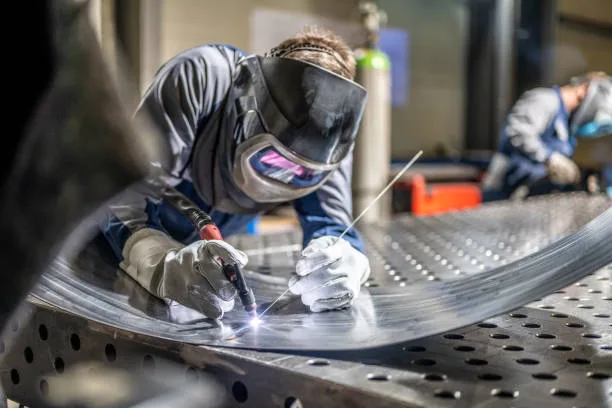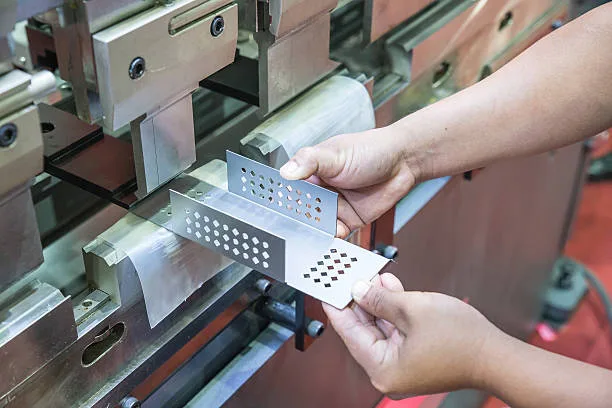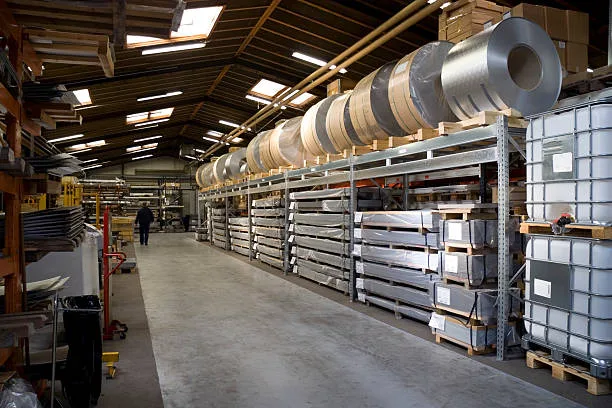
Introduction
Modern production now heavily relies on the craft with great inventiveness and lengthy history: sheet metal fabrication. From the forges of ancient blacksmiths to today’s high-tech production lines, sheet metal fabrication has gone a long and rich developmental trip. This technique has changed in craft and technology innovation as well as in form and scale.
Usually referring to metal sheets, a material extensively used in many different disciplines because of its formability and simplicity of processing, sheet metal is Sheet metal fabrication is absolutely essential in aerospace, automotive, construction engineering, precision instruments and daily household products. Its relevance in contemporary life is highlighted by its great spectrum of uses and major influence.
As industrial technology developed, methods of sheet metal manufacturing likewise changed constantly. From basic cold working to sophisticated heat treatments and surface processes, from first hand forging to modern automated machining, every stage in sheet metal fabrication shows the wonder and complexity of precise engineering. Thanks to manufacturing (CAM) technologies and modern computer-aided design (CAD), sheet metal fabrication today boasts more accuracy and efficiency.
We shall explore several facets of sheet metal fabrication in this paper. We seek to fully grasp the art and science of sheet metal fabrication from choosing the appropriate materials to thorough study of several fabrication techniques and finishing processes to investigating several joining methods and finishing tools. We also will discuss its uses in several sectors and how it has evolved to support and propel their growth.
Fabrication of sheet metal is an art as well as a method. Craftsmen must possess not just great talent but also creative thought and rigorous attention to detail. New materials and the use of modern technologies will open countless opportunities for sheet metal manufacturing going forward. With this paper, we intend to give readers a comprehensive and in-depth reference to the skill of sheet metal manufacturing, so clarifying this discipline.

What are the Raw Materials Used in Sheet Metal Fabrication?
The basic building block of sheet metal manufacturing is the raw materials applied. Choosing the suitable materials influences not only the manufacturing process but also the quality and application range of the resulting good. These are some often used materials in sheet metal manufacturing together with their properties:
Stainless Steel
Typical Types: Has grades ranging from 304 to 316, 410 to 430.
Grade 304 stainless steel’s great formability and corrosion resistance help to explain its great popularity. Perfect for chemical equipment and marine uses, grade 316 boasts excellent high-temperature and corrosion resistance. Often used in the manufacture of cutlery, grade 410 has heat-treatable qualities but reduced corrosion resistance. For uses when corrosion resistance is not a top concern, Grade 430 is a reasonably priced choice.
Aluminum
Common Types: Contains grades ranging from 6006-T6 to 1100-H14, 3003-H14, 5052-H32.
Possibilities: With so many uses, aluminum is lightweight and easy to work with. Commercial-purity aluminum with strong chemical stability and weldability but reduced strength, 1100-H14 is Commonly found in stamping and spinning parts, 3003-H14 has more strength than 1100. Fit for electronic enclosures, 5052-H32 has great strength and good corrosion resistance. Modern aircraft construction make advantage of the often used heat-treatable structural aluminum alloy 6061-T6.
Brass
One often used copper alloy in the sheet metal industry is brass. It is frequently used in applications needing decorative appeal, easy to process, has strong mechanical qualities and corrosion resistance.
The technical needs throughout the production as well as the demands of the finished product determine the suitable materials to be chosen. For instance, the choice of processing techniques and the complexity of the process will be influenced by elements including the strength, ductility, heat resistance, and corrosion resistance of several materials. Furthermore taken into great account, particularly in mass production, are material costs. Therefore, in sheet metal fabrication, the choice and application of materials need a thorough examination of many elements to guarantee the performance and financial economy of the product.
[embedyt] https://www.youtube.com/watch?v=oHHGOc1alrg[/embedyt]
What is the Sheet Metal Fabrication Process Like?
The process of sheet metal fabrication consists in several phases that convert metal sheets into particular forms and dimensions. From simple cutting and molding to intricate joining and assembly, this procedure employs several techniques. The following are the main stages in sheet metal fabrication:
Cutting and Shearing
- Cutting Techniques: Shearing, band saw cutting, plasma cutting, and laser cutting all fall under the first phase in sheet metal processing—cutting. The thickness of the material and the needed precision guide the selection of these methods.
- Shearing Techniques: Using cutting torches or CNC cutting tools—such as plasma cutters and laser cutters—shearing is These techniques enable exact cutting of intricate forms and patterns.
Forming
- Forming Methods: Forming is the three-dimensional construction process from flat sheet metal. Common shaping techniques consist on bending, stamping, and deep drawing.
- Stamping: Stamping is a pressure-applying technique for precisely shaping metal sheets into particular forms. Complicated items like car body components are produced from it.
- Deep Drawing: Stretching the metal sheet allows one to create deep, recessed forms in deep drawing. Kitchen tools and automobile parts are routinely manufactured using this technique.
Roll Forming
- Roll Forming Process: By means of constant bending operations, roll forming is a technique for precisely forming metal sheets into desired cross-sectional forms. For making lengthy metal parts, such as car chassis components and door frames, it is appropriate.
- Advantages of Roll Forming: This approach preserves great uniformity and accuracy of the produced goods, fits for large production, and enables continuous production.
Digital Simulation
- Simulation Technologies: To forecast and maximize the metal forming process, sheet metal fabrication makes more and more use of computer simulation tools including finite element analysis in recent years.
- Application Value: Simulating several manufacturing situations helps to evaluate part manufacture before real production, therefore greatly lowering the cost and time required in physical testing.
These processes mirror the variety and complexity of sheet metal manufacturing. Every stage calls for exact engineering design and technical execution to guarantee that the end result satisfies the necessary criteria for quality and specification. Thanks to technology developments, these conventional techniques are getting more exact and efficient, providing more design and manufacturing options across many sectors.

What are the Joining Processes in Sheet Metal Fabrication?
Assembling individual sheet metal parts into the finished product in sheet metal production depends critically on the connecting technique. Various connecting techniques can be chosen based on the product’s design and functional criteria. Common connecting methods applied in sheet metal fabrication include these ones:
Welding
Commonly used joining technique is welding, in which melting the material permanently bonds two or more sheet metal sections. Arc welding, gas welding, laser welding, and spot welding are few common forms of welding. Every approach has particular uses and benefits as well as drawbacks.
Riveting
Riveting is the mechanical connection of two or more pieces accomplished with rivets. It is appropriate for buildings that need disassembly or for circumstances when welding is not feasible, as in military and aerospace uses.
Brazing and Soldering
Brazing and soldering heat and apply a filler metal to unite pieces. Applications needing careful handling and stronger joints call for these methods.
Bolting and Screwing
One detachable approach is joining with bolts and screws, which facilitates simple component separation for next repairs or replacements. Because of its robustness and adaptability, this approach is very frequent in manufacturing of large machines and buildings.
Adhesive Bonding
Adhesives are used in adhesive bonding to unite pieces. Applications where a tidy appearance and imperceptible connection points are required greatly benefit from this method. Modern adhesives’ advancement has made bonding possible to give strength and durability equivalent to conventional mechanical joining techniques.
When deciding on the suitable joining technique, one should take into account the design needs, application environment, cost, and manufacturing efficiency of the product since every joining technology has particular advantages and limits. Maintaining the quality and performance of sheet metal goods depends on exact and suitable application of these joining methods.

What are the Main Characteristics and Applications of Punching and Perforating in Sheet Metal Fabrication?
Important techniques in sheet metal manufacturing used to produce holes are punching and perforating. These methods produce not only holes but also several forms of notches, slots, and cut patterns. The following are the primary traits and uses for the punching and perforating techniques:
Characteristics of Punching
A cheap and quick way to produce a range of hole forms in sheet metal is punching. Quick completion of this process makes it appropriate for medium to large volume sheet metal processing.
Geometric Characteristics of Punching
To create holes of various shapes, punching can be done on plastics and metals among other things. Changing the punch and die shapes will help one to obtain the geometric forms in the punching process, therefore addressing different design requirements.
Punching Equipment
Usually involving mechanical presses, the punching process also makes use of hand punching equipment. Large CNC (Computer Numerical Control) punching machines are prevalent in industry since they provide great processing efficiency and accuracy.
Perforating Techniques
Usually involving drill bits or other cutting equipment, perforating is making holes in sheet metal. The necessary size and form of the holes will let one choose different kinds of drill bits and cutting equipment.
Application Scope
Manufacturing electrical panels, ventilation systems, decorative accents, and other sheet metal items needing exact hole placement makes extensive use of punching and perforating procedures.
Design Considerations
Punching and perforating should be taken into account while developing sheet metal parts regarding material integrity and strength. Ensuring the operation and appearance of the finished product depends on precisely determining the hole size and location.
While sheet metal pieces provide a basis for additional assembly and processing, punching and perforating helps them to attain better functionality and beauty. Product quality and performance depend on exact use of these techniques.
What are the Post-Processing and Surface Treatment Techniques in Sheet Metal Fabrication?
Important measures that improve the visual appeal and longevity of the product and offer another layer of protection against corrosion and wear in post-processing and surface treatment in sheet metal production include Following are some typical surface treatment and post-processing methods applied in sheet metal production:
Anodizing
On aluminum products, this electrochemical procedure is utilized to raise surface corrosion and wear resistance. Furthermore producing different colors on the metal surface, anodizing helps to improve the product’s visual attractiveness.
Galvanizing
Galvanizing—that is, covering the steel surface with zinc to stop rusting—requires Sheet metal products in outdoor or humid environments—that is, in building and infrastructure components—often make use of it.
Heat Treatment
Metal’s physical and chemical characteristics are changed by heat treatment therefore enhancing its wear resistance and strength. Many times, this approach is utilized to change the metal’s hardness and toughness.
Polishing
The metal surface’s shine and smoothness are raised via polishing. It may eliminate manufacturing process defects and scratches, therefore giving the product a high-end appearance and aesthetic attractiveness.
Electroplating
Deposition of a coating of another metal on the metal surface is known as electroplation. It is usually used to raise surface hardness, enhance corrosion resistance, or provide a decorative impact.
Painting and Coating
Painting and coating are processes of adding color and further protection by laying paint on a metal surface. Manufacturing of furniture, cars, and electronic goods all make extensive use of these techniques.
Every post-processing and surface treatment method has particular uses and consequences. The final usage of the product, the intended aesthetic effect, and the budget will determine the suitable therapy approach. Correct surface treatment and post-processing not only raise the product’s durability and quality but also greatly increase its market competitiveness.

What are the Quality Control and Standards in Sheet Metal Fabrication?
The process of sheet metal production depends much on quality control, which guarantees that goods satisfy particular standards of performance and quality. Following standards and applying quality control in sheet metal manufacturing mostly depends on these factors:
Quality Control Processes
From raw material inspection to final product testing, the quality control process spans all aspect of manufacturing. This covers inspections of material quality, manufacturing process accuracy, appearance and utility of the resultant product:
International and Industry Standards
To guarantee product quality and safety, sheet metal fabrication complies with several worldwide and industry standards including ISO (International Organization for Standardization) criteria. These criteria address material standards, manufacturing techniques, product performance, and safety criteria.
Testing and Inspection Methods
Common techniques of inspection are mechanical tests (like tensile strength testing), dimensional measurements, visual inspections, and chemical analysis. For particular uses, such those in the automobile or aerospace sectors, there can be more testing needs.
Continuous Improvement
A constant process of improvement, quality control requires frequent assessment and adjustments to fit changes in new technology and market expectations. This covers staff regular training, technological and equipment updating, production and inspection process improvement.
Documentation and Record Keeping
Quality control depends much on thorough manufacturing and inspection records. Not only are these data tracked for product quality, but they also help satisfy regulatory needs and customer audits.
Customer Feedback
Quality control is mostly dependent on customer comments, which also help to spot possible problems and motivate product development. Active client communication and feedback collecting help companies to better grasp market needs and raise customer satisfaction by means of which.
To guarantee the quality and performance of sheet metal goods, good quality control and industry standard adherence are therefore absolutely vital. This influences not only the market competitiveness of the product but also is fundamental for the company’s reputation preservation and sustainable development.
What are the Industry Applications and Case Studies of Sheet Metal Fabrication?
Sheet metal production has extensive uses in many different sectors thanks to its adaptability and diversity. Here are some common uses and associated case studies of sheet metal manufacturing in several sectors:
Aerospace Industry
Sheet metal fabrication finds application in the aerospace sector in the manufacturing of engine components, wing surfaces, and aircraft fuselages.
Case Study: A specific model of a commercial airplane makes great use of sheet metal parts for its wings and fuselage; exact stamping and shaping techniques guarantee the components’ lightweight and structural strength.
Automotive Industry
In the automotive sector, sheet metal fabrication produces internal structural components, chassis, and body panels.
Case Study: Popular electric car model used creative sheet metal bending methods to lower welding sites, therefore improving the general rigidity and safety of the vehicle.
Construction Industry
Sheet metal finds application in the building industry as decorative panels, exterior wall cladding, and roofing.
Case Study: Custom sheet metal exterior panels used in a contemporary office building allowed for distinctive visual appeal by means of creative bending and cutting designs.
Electronics and Appliances Industry
Sheet metal is mostly utilized in electronics for manufacture of enclosures and heat sinks including computer cases and mobile device housings.
Case Study: Using thin sheet metal components for its body, a new laptop model achieves a sleek yet robust design.
Medical Equipment
Sheet metal finds use in the medical field for supports, medical device casings, and surgical tools.
Case Study: A medical equipment business created a portable X-ray machine with a sophisticated sheet metal enclosure guaranteeing utility and longevity in addition to visual appeal.
Energy Industry
Sheet metal finds use in the energy industry for making solar panel supports, wind turbine components, and more.
Case Study: The sheet metal built support system offered a dependable and reasonably priced solution in a big solar power plant.
These examples show how extensively sheet metal fabrication is used in different sectors and how creatively design and effective manufacturing techniques satisfy certain industry needs. By means of these applications, sheet metal production not only highlights its relevance in terms of functioning but also significantly influences aesthetics and creative design.
Conclusion
Modern industrial production depends much on sheet metal fabrication as a flexible and extensively used manufacturing method. From aircraft to the building sector, from precision electronics to domestic goods, from sheet metal fabrication finds practically all use in almost all production fields. By means of the exploration in this article, we have not only grasped the fundamental techniques of sheet metal fabrication—that is, cutting, forming, joining, and surface treatment—but also explored the significance of quality control and the uses in several sectors.
As technology is developing constantly, sheet metal manufacturing is presented both possibilities and problems. While increasing design flexibility, the advent of digitalization and automation technologies has made the manufacturing process more exact and efficient. Furthermore, sheet metal fabrication is always changing to fulfill better performance criteria and environmental criteria as new materials and more focus on environmental sustainability develop.
Sheet metal manufacturing is an art as much as a method overall. Manufacturers have to be not just very skilled but also creative thinkers and rigorous quality controllers. As technology develops and market needs change, sheet metal fabrication will keep changing and provide more value and creativity to different sectors.
Sheet metal fabrication will surely remain a major factor in enhancing manufacturing efficiency, inspiring design creativity, and accomplishing sustainable growth as well as in other areas. Sheet metal fabrication will surely remain in a major role in the worldwide industrial sector by means of ongoing technical innovation and process enhancement.
Having 27 years of professional experience, Honjenny provides a broad spectrum of manufacturing capabilities including customizing services in Die Casting, Cosmetic Packaging, CNC Precision Machining, 3D Printing, and Sheet Metal Fabrication. We meet all your prototype design and manufacturing requirements by covering several industries including Home Castings, Beauty Castings, Electronic Castings, Medical Castings, and Automobile Castings. For further information or a free, non-obligatory quotation, visit our website, https://honjenny.com.

